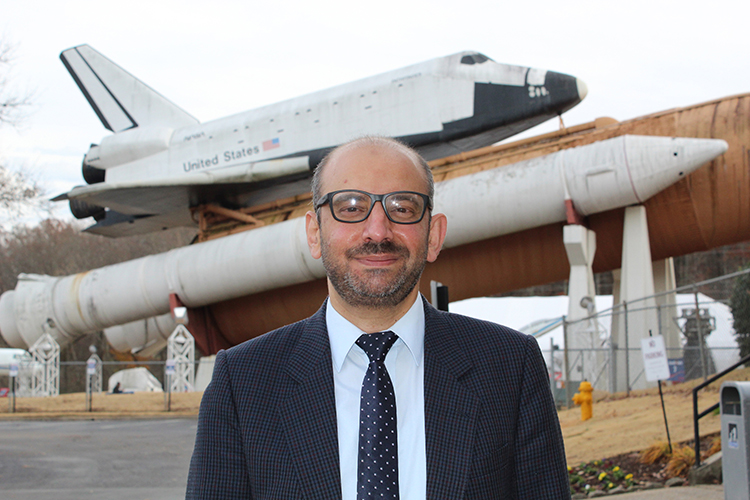
Mohammad Z. Al-Hamdan is the new director of the National Center for Computational Hydroscience and Engineering at the University of Mississippi. Submitted photo
Mohammad Al-Hamdan to head National Center for Computational Hydroscience and Engineering
A University of Mississippi center that is a global leader in the science and research of water management and soil conservation has a new director.
Mohammad Z. Al-Hamdan has been named director of the National Center for Computational Hydroscience and Engineering, or NCCHE. Established in 1982, the center uses the fields of computational hydroscience and engineering to develop new research and engineering tools, conduct scientific research, advance engineering analysis and design, and create environmental and ecological impact assessments in the areas of soil and water conservation.
Al-Hamdan was previously a principal research scientist with the Universities Space Research Association at NASA‘s Marshall Space Flight Center and the Global Hydrology Resource Center.
“I’m very excited about this opportunity to be in a position to steer the trajectory of a prestigious research center at a prestigious university and lead it to more growth and greater success,” said Al-Hamdan, who joined UM in late 2020.
“I am very passionate about conducting impactful research; establishing large interdisciplinary initiatives, collaborations and partnerships; and providing mentorship to students, postdocs and early-career faculty and scientists. And all of these passions of mine are perfectly consistent with the missions of the NCCHE and Ole Miss.”
Al-Hamdan also serves as a research professor in the UM Department of Geology and Geological Engineering and as an associate professor of civil engineering.
“We are thrilled to have Dr. Al-Hamdan joining us to lead the NCCHE,” said David Puleo, dean of the School of Engineering, where the center is based. “He brings an infectious enthusiasm that complements his technical abilities and tremendous prior experience. I look forward to seeing Dr. Al-Hamdan implement his vision for the center.”
Al-Hamdan earned both his master’s and doctoral degrees in civil and environmental engineering from the University of Alabama in Huntsville and his bachelor’s in agricultural/water resources engineering from the Jordan University of Science and Technology.
“Dr. Al-Hamdan is an established researcher who will enhance the research mission of both the University of Mississippi and the NCCHE,” said Greg Easson, recent interim director of the NCCHE, professor of geology and geological engineering, and director of the Mississippi Mineral Resources Institute at Ole Miss. “His research and academic experience will take the NCCHE to new heights.”
Al-Hamdan’s research is focused in fields such as remote sensing and geographic information system applications to water resources modeling; applying these techniques to environmental modeling and assessment for water, air, coastal, ecological and public health applications; and impacts of land cover, land use and climate changes on water quantity and quality, public health and aquatic ecosystems sustainability.
While water covers more than 70 percent of the Earth’s surface, only 3 percent of that is fresh water and less than 1 percent is available or accessible fresh water.
“I have always been interested in learning how to preserve and manage this most precious and essential element for our life, because if you do that, you’ll contribute to preserving people’s lives and livelihoods, and, in my view, there is no better contribution to society than that,” Al-Hamdan said. “In regards to remote sensing technology, it provides great data and tools to improve the predictions and simulations of water quantity and quality modeling and decision support systems.
“That’s why I have always wanted to be a civil and environmental engineer who’s focusing on water resources and environmental research and applications using remote sensing and geospatial technologies.”
While at the Universities Space Research Association, Al-Hamdan conceived, managed or worked on research projects totaling more than $21 million, with funding coming from federal agencies such as NASA, the National Institutes of Health, the National Science Foundation, the Department of Defense, the Environmental Protection Agency, National Oceanic and Atmospheric Administration, the U.S. Geological Survey, and Department of Transportation.
During his career, Al-Hamdan’s research work has resulted in more than 220 peer-reviewed journal, conference and technical report publications.
Al-Hamdan also has been an adjunct faculty member at Jackson State University, San Jose State University, Meharry Medical College, the University of Alabama in Huntsville, and the University of Alabama at Birmingham.
As a faculty member, he has taught several undergraduate and graduate courses related to hydrology, geographic information systems, environmental engineering, water quality, fluid mechanics and more. His classroom work also has involved serving on graduate committees of Ph.D. students and mentoring graduate, postdoctoral and early-career faculty fellowships funded by NASA, the National Science Foundation and the National Institutes of Health.
“All of these students and postdocs went ahead to be accepted at elite graduate schools or started very successful careers at highly respected organizations,” Al-Hamdan said.
“Furthermore, I have mentored early-career scientists on how to lead, develop and write successful research proposals, and also been involved with research and education projects that involve mentoring students and early-career faculty to enhance the research skills of early-stage investigators in the areas of meteorology, hydrology, water quality, air quality and environmental public health.”
Based at the university’s South Oxford Center, the NCCHE is renowned for its expertise in modeling water flow, sediment transport and soil erosion and their effects on water resources, soil conservation, flood control, waterways safety and more.
The center’s research and development activities cover fields such as watershed processes, channel network hydraulics, river morphology, flood analysis, dam break, sediment transport, water quality and pollutant transport, and river training and restoration.
Its research led to the development of a dam and levee-break flood modeling and mapping software called Decision Support System for Water Infrastructural Security and, later, a web-based version of the software.
Operated for the Federal Emergency Management Agency, the software provides analytical capabilities and a decision support system for dam and levee security free-of-charge around the clock to FEMA, state dam safety offices and stakeholder federal and state agencies.
Since its inception in 2012, the software has run more than 35,000 simulations.
As a research unit of the School of Engineering, the center also educates future researchers and engineers through its graduate degree programs and assists professionals in the field through short courses and workshops.
Beyond its research and educational components, the center works with government agencies and private institutions on hydroscience- and engineering-related research and engineering projects.
“Throughout my professional career, I’ve been leading several research and educational activities related to all aspects of NCCHE’s missions,” Al-Hamdan said. “My ultimate goal is to make NCCHE even more nationally and internationally recognized as the ‘go-to’ organization for water-related interdisciplinary, impactful research.
“And to that end, my top priority and immediate goal are to grow and expand the breadth of NCCHE’s internal and external partnerships and collaborative efforts, and diversify its research portfolio and funding opportunities.”
By Shea Stewart




